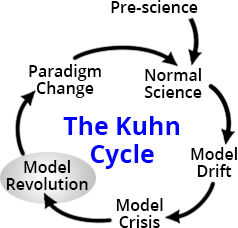Model Revolution

Click a node to read about it.
Model revolution is the fourth step of the Kuhn Cycle. In this step a field's model of understanding is undergoing revolutionary change. The old model failed, which caused the Model Crisis step. The Model Revolution step begins when one or more competing new models emerge from the crisis.
This step is a revolution because the old model is usually so entrenched into the mental habits and even the lifestyles of those using it that a new way of thinking is incomprehensible and/or unacceptable, at least at first. The Model Revolution step could also be called The Search for a New Model That Works step. The length of this step is best minimized if the consequences to failing to find a new model in time are catastrophic. Unless this step is driven by an appropriate process it is almost always rocky, unnecessarily slow, and unpredictable.
Why understanding the Model Revolution step is important
This step is routine in science, where the Model Revolution step is welcomed. Debate sprawls across peer reviewed journal articles, conferences, talks, and conversations. Healthy unselfish debate and cooperative exploration has always generated the single new model a field needs. When this occurs, the Model Revolution step is complete and the next step begins.
This step is not routine when the model is not that of a field, but of a culture or a model of government. When those new models compete people have a lot to lose. They can lose most of their assets or their life, as has happened in thousands of violent revolutions and wars. The Model Revolution step is thus fraught with danger when social control models are at stake. A social control model is a collection of rules describing how a unit of society works.
That the sustainability problem exists is evidence that the world's social control models have failed. Here the model is government and its many laws. Several things in that model are deeply flawed and must be changed. But historically, deep changes to government have required revolutions, some mild, and some not.
The Two Requirements for Successful Model Revolution
Thomas Kuhn argued that the heart of why a new paradigm is accepted depends on two requirements:
First, the new candidate must seem to resolve some outstanding and generally recognized problem that can be met in no other way. Second, the new paradigm must promise to preserve a relatively large part of the concrete problem solving activity that has accrued to science through its predecessors. 1
The essence of the new paradigm promoted by Thwink.org is that the process must fit the problem. The System Improvement Process (SIP) is presented as an example of a better fit. SIP satisfies the two requirements described by Kuhn, and thus has the potential to cause the new paradigm to be swiftly accepted.
The first requirement is that "the new candidate must seem to resolve some outstanding and generally recognized problem that can be met in no other way." The outstanding problem of environmental activism is that despite decades of work and mountains of proof that civilization should change course, it has not. The new paradigm resolves this by introduction of the proposition that change resistance is the reason for this, and that if systemic changer resistance is analyzed as a separate problem it will quickly yield to root cause analysis, which will reveal deep solutions which have never been tried and have a high probability of success.
The second requirement is that "the new paradigm must promise to preserve a relatively large part of the concrete problem solving activity that has accrued to science through its predecessors." SIP accomplishes this by the concept of the proper coupling subproblem. The Normal Science of environmentalism considers proper coupling to be the problem to solve. SIP views it as merely one of three subproblems: how to overcome change resistance, how to achieve proper coupling, and how to avoid avoid excessive model drift. This decomposition preserves the "relatively large part of the concrete problem solving activity" that centers on proper coupling.
In other words, once environmentalists use the new insight that change resistance is the crux of the problem, then after it's overcome they can return to what they have been doing for so long: addressing the proper coupling part of the problem.
Thus the new paradigm is not that big a change after all. It's evolutionary rather than revolutionary.
(1) From the first edition of The Structure of Scientific Revolutions, page 168, as cited in the Wikipedia entry on The Structure of Scientific Revolutions.


























